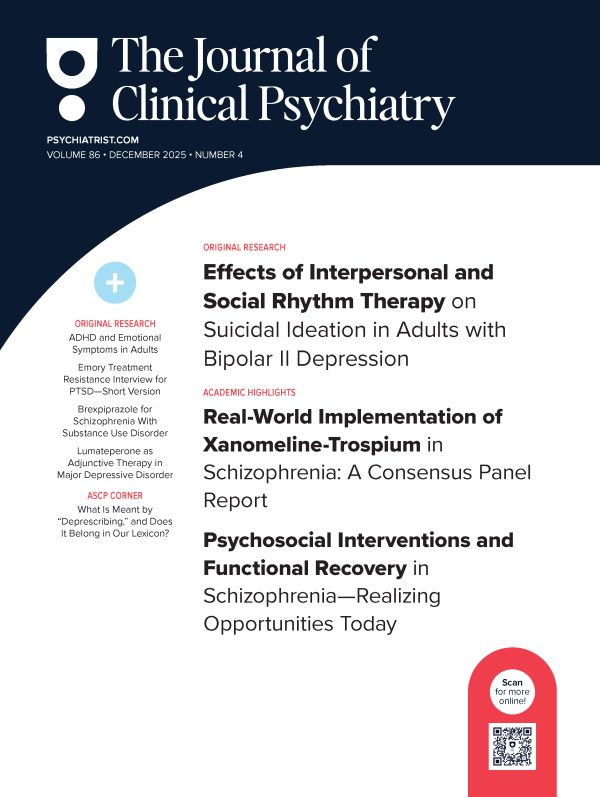Introduction: A Fresh Look at Monoamine Oxidase Inhibitors for Depression
According to the World Health Organization (WHO), depression is currently a leading cause of disability worldwide, affecting 121 million people, and is expected to be the second greatest cause of disability by 2020.1 Depression is a complex disorder, and individuals with depression have varying symptoms, history, illness course, and treatment response.2
Due to its heterogeneity, depression can be classified into subtypes that encompass specific symptoms, and identifying the subtype can help clinicians determine the direction of the treatment plan for some patients. For example, atypical depression is a subtype that includes mood reactivity combined with an increase in appetite or weight gain, hypersomnia, leaden paralysis, and/or sensitivity to interpersonal rejection.3 Individuals who have atypical depression typically have an earlier age at onset and a more chronic course of illness, and they are less responsive to the first-line antidepressants, selective serotonin reuptake inhibitors (SSRIs).4 Even many depressed patients without atypical features do not achieve remission with first-line treatments and continue to experience residual symptoms, which increases the risk for poor long-term outcomes and relapse.5
Although a large armamentarium of treatments for depression is available, some antidepressants are more effective than others for certain patients. For example, monoamine oxidase inhibitors (MAOIs) are particularly effective for those with atypical or treatment-resistant depression.6 Although the efficacy of MAOIs for these depressive subpopulations has been long established, the low prescription rate of MAOIs, probably due to the potential for rare but severe adverse events,7 indicates that many patients who may benefit from these agents are not receiving them.6
Despite their side effect profiles, the effectiveness of MAOIs led to sustained interest in these drugs and provided incentive to develop new formulations, such as the transdermal system of delivery, that are better tolerated than the older MAOIs.8 These newer formulations include an oral MAO-A selective MAOI, although it is not available in the United States, and a transdermal MAOI that was approved in 2006. In this Supplement, national experts on depression present a comprehensive overview of MAOIs and explain how the transdermal formulation fits into the current antidepressant armamentarium for clinicians.
To better understand depression as a disease, Robert M. A. Hirschfeld, MD, examines the clinical course, psychosocial burden, and differential diagnosis of this condition as well as its categorization in the current edition versus the upcoming edition of the Diagnostic and Statistical Manual of Mental Disorders (DSM). He then presents a basic overview of the history of depression treatments, beginning in the 1930s with seizure and convulsive treatments and leading up to present-day SSRIs and dual-acting antidepressants.
Michael E. Thase, MD, then continues the depression-treatment perspective and systematically details the inclusion of MAOIs in American, European, and international depression treatment guidelines.
To delve into the safety and tolerability of MAOIs, David A. Flockhart, MD, PhD, elucidates the mechanisms of action that contribute to potential serious adverse events like hypertensive crisis and serotonin syndrome. He then specifically outlines the necessary dietary and drug restrictions required with some MAOIs, discusses each of the newer MAOIs and their propensity for interactions with food and drugs, and points to the personalization of medicine as a direction of future depression treatment.
Chad M. VanDenBerg, PharmD, BCPP, expands on the mechanism of action of MAOIs and concentrates on the newest development in this class of medication, the transdermal formulation. He highlights the pharmacokinetics, pharmacodynamics, efficacy, and safety and tolerability profiles of the MAOI skin patch, as well as compares transdermal and oral medications.
Finally, we describe how to accurately assess true nonresponse versus medication nonadherence, how to enhance treatment adherence, and how transdermal antidepressant delivery may be a useful alternative to oral medications for patients with adherence problems.
To further analyze adherence issues and to collaborate on the use of MAOIs in clinical practice, the faculty for this Supplement also participated in an in-depth and thought-provoking discussion. Some of the topics deliberated upon were where to include different MAOIs, particularly the transdermal formulation, in the depression treatment guidelines and what information clinicians and patients need to know when administering medications via a skin patch.
References
1. World Health Organization. Mental health: depression. http://www.who.int/mental_health/management/depression/definition/en/. Updated 2012. Accessed June 7, 2012.
2. Rush AJ. The varied clinical presentations of major depressive disorder. J Clin Psychiatry. 2007;68(suppl 8):4-10. PubMed
3. American Psychiatric Association. Diagnostic and Statistical Manual of Mental Disorders, Fourth Edition, Text Revision. Washington, DC: American Psychiatric Association; 2000.
4. Thase ME. Recognition and diagnosis of atypical depression. J Clin Psychiatry. 2007;68(suppl 8):11-16. PubMed
5. Zajecka JM. Treating depression to remission. J Clin Psychiatry. 2003;64(suppl 15):7-12. PubMed
6. Shulman KI, Fischer HD, Herrmann N, et al. Current prescription patterns and safety profile of irreversible monoamine oxidase inhibitors: a population-based cohort study of older adults. J Clin Psychiatry. 2009;70(12):1681-1686. PubMed doi:10.4088/JCP.08m05041blu
7. Schatzberg AF. Safety and tolerability of antidepressants: weighing the impact on treatment decisions. J Clin Psychiatry. 2007;68(suppl 8):26-34. PubMed
8. Patkar AA, Pae CU, Masand PS. Transdermal selegiline: the new generation of monoamine oxidase inhibitors. CNS Spectr. 2006;11(5):363-375. PubMed
From the Department of Pharmacotherapy, the Department of Health Policy and Administration, and the Pharmacoeconomics and Pharmacoepidemiology Research Unit, Washington State University College of Pharmacy, Spokane (Drs Cohen and Sclar); the Washington Institute for Mental Health Research and Training, Spokane (Drs Cohen and Sclar); and the Department of Pharmacotherapy, University of North Texas Health Science Center, Fort Worth (Dr Cohen).
This article is derived from the planning teleconference series "A Fresh Look at Monoamine Oxidase Inhibitors for Depression," which was held December 2011 through February 2012 and supported by an educational grant from Mylan Specialty L.P. (formerly known as Dey Pharma, L.P.).
Dr Cohen is a consultant for Dey and has received honoraria from and is a member of the speakers/advisory boards for Sunovion and Merck.
Dr Sclar is a consultant for and has received grant/research support and honoraria from Eli Lilly, Pfizer, GlaxoSmithKline, Forest, Dey, and Bristol-Myers Squibb and is a member of the speakers/advisory board for Eli Lilly.
Corresponding author: Lawrence J. Cohen, PharmD, BCPP, FASHP, FCCP, FCP, University of North Texas Health Science Center, 3500 Camp Bowie Blvd, Fort Worth, TX 76107 ([email protected]).
doi:10.4088/JCP.11096su1c.00
© Copyright 2012 Physicians Postgraduate Press, Inc.



